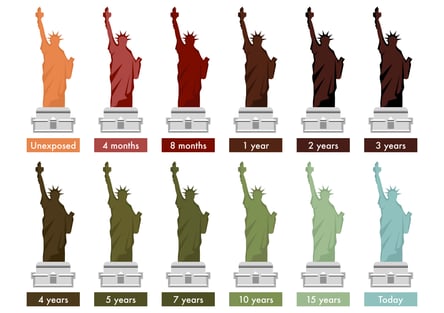“The first step to change is awareness. The second step is acceptance.”
~Nathaniel Branden

This colorful chart shows patina growth on the copper skin, a corrosive reaction on the Statue of Liberty over time. In its spot in NY harbor, Lady Liberty would naturally and constantly be exposed to all corrosive elements always present in that location.
Non-ferrous metals, including Silver, Copper and Brass, tarnish by reacting with corrosive gases such as Oxygen, COS, SO2, HCl and H2S. These corrosive gases are formed by chemical reactions occurring not just near to ocean surfaces, but in decaying vegetation, industrial smokestack effluent, burning fossil fuels (such as from cars, wood fires, agricultural burn seasons etc.), oil refining, pulp mills, as well as many other natural sources. These gases are in every environment – studies have documented corrosive gases even in humidity-controlled storage areas. Patina growth on her copper shell does act as a barrier for the Statue, so corrosion won’t bore all the way through, as it might with ferrous metals.
Consider the four-month level shown on the chart. Is that acceptable for your non-ferrous products? Quite frankly most materials that are in your product will be affected by corrosive gases. Think of the shipping challenges going on in the world of late. Just recently, ports were left unable to unload containers due to labor problems, causing container ships to be stranded on the ocean awaiting their turn at the dock.
More recently, the Suez Canal had a blockage, the Panama Canal is backed up, and now the Red Sea has become a war zone. All leading to more time on the ocean surfaces. Once your product leaves your facility, you lose a measure of reliability control.
A multitude of unexpected challenges could lead to additional time in a corrosive environment for your products in transport, and no guarantee of their quality once they reach final destination unless they are packaged safely, with a reactive barrier against corrosion like Intercept packaging.
Prepare for the unexpected, by choosing Intercept Technology packaging that will react and neutralize corrosive gases to protect your products and keep them at peak quality, ready for use.
Liberty Intercept Blog
Statue of Liberty Copper Patina = Corrosion
Posted by Joe Spitz on Feb 6, 2024 3:03:28 PM
“The first step to change is awareness. The second step is acceptance.”
~Nathaniel Branden
This colorful chart shows patina growth on the copper skin, a corrosive reaction on the Statue of Liberty over time. In its spot in NY harbor, Lady Liberty would naturally and constantly be exposed to all corrosive elements always present in that location.
Non-ferrous metals, including Silver, Copper and Brass, tarnish by reacting with corrosive gases such as Oxygen, COS, SO2, HCl and H2S. These corrosive gases are formed by chemical reactions occurring not just near to ocean surfaces, but in decaying vegetation, industrial smokestack effluent, burning fossil fuels (such as from cars, wood fires, agricultural burn seasons etc.), oil refining, pulp mills, as well as many other natural sources. These gases are in every environment – studies have documented corrosive gases even in humidity-controlled storage areas. Patina growth on her copper shell does act as a barrier for the Statue, so corrosion won’t bore all the way through, as it might with ferrous metals.
Consider the four-month level shown on the chart. Is that acceptable for your non-ferrous products? Quite frankly most materials that are in your product will be affected by corrosive gases. Think of the shipping challenges going on in the world of late. Just recently, ports were left unable to unload containers due to labor problems, causing container ships to be stranded on the ocean awaiting their turn at the dock.
More recently, the Suez Canal had a blockage, the Panama Canal is backed up, and now the Red Sea has become a war zone. All leading to more time on the ocean surfaces. Once your product leaves your facility, you lose a measure of reliability control.
A multitude of unexpected challenges could lead to additional time in a corrosive environment for your products in transport, and no guarantee of their quality once they reach final destination unless they are packaged safely, with a reactive barrier against corrosion like Intercept packaging.
Prepare for the unexpected, by choosing Intercept Technology packaging that will react and neutralize corrosive gases to protect your products and keep them at peak quality, ready for use.
Topics: barrier packaging, better packaging, manufacturers, Statue of Liberty, manufacturing, quality, corrosion prevention
Related Posts
Your Lifeline in a Chaotic Supply Chain
Packaging's Crucial Role vs FOD
Leave a Comment